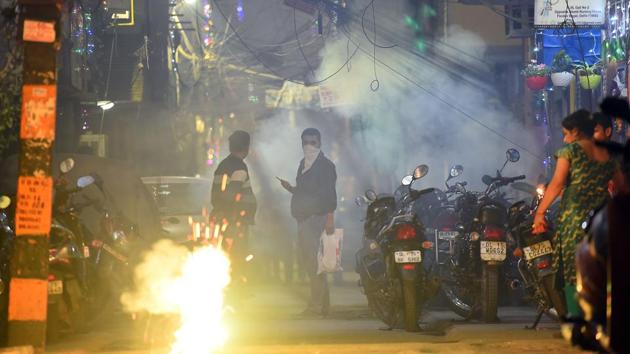Finer, deadlier PM1 shoots up in Delhi due to crop burning, crackers
PM1 is so fine that it can reach the blood stream and organs. Scientists say these particles are highly toxic as they are formed by complex chemical reactions between pollutants in the air, and are at least 50-70 times finer than human hair.
Unchecked instances of crop stubble burning in the neighbouring states of Punjab and Haryana and the cracker bursting in Delhi on Diwali has resulted in a steep rise in the tiniest and deadliest of air pollutants, the PM1 or particulate matter with a diameter less than 1 micrometres, in the Delhi-NCR between October and November, according to a joint research by three Central universities.

PM1 is so fine that it can reach the blood stream and organs. Scientists say these particles are highly toxic as they are formed by complex chemical reactions between pollutants in the air, and are at least 50-70 times finer than human hair. In comparison, PM10 is around 5-7 times finer than hair, and PM2.5 is around 20-30 times finer. PM10 can reach up to the upper air passage of the human body, and PM2.5 can reach the lungs.
The new analysis conducted by researchers from Indian Institute of Technology (IIT) Delhi, Jawaharlal Nehru University (JNU) and the Delhi University shows that the levels of PM 1 in Delhi was between 200ug/m3 and 300ug/m3 in October and November, as compared to less than 100ug/m3 in September this year.
Unlike PM2.5 and PM10, which have set permissible limits, there is still no global safe limit for PM1 because it is a pollutant which started being measured only recently.

Between November 6 and November 11, the 24-hour observations show a very high concentration of both PM2.5 and PM1. The analysis was conducted jointly by SK Dhaka, associate professor of physics, Rajdhani College, Delhi University; AP Dimri, professor, JNU; and Palak Balyan, Centre for Atmospheric Sciences, IIT-Delhi.
While the levels of PM1 are not recorded by either the Central Pollution Control Board or the Delhi Pollution Control Committee, the analysis has been conducted based on a new network of low-cost sensors set up in Delhi-NCR and in Haryana, Punjab and western Uttar Pradesh. The initiative has been funded by National Aeronautics and Space Administration (Nasa) and is led by RTI International, in collaboration with IIT-Delhi and Council on Energy, Environment and Water (CEEW).
At present, there are about 35 sensors operational, which are providing real time data along with temperature and humidity. The analysis shows that PM1 particles were of high density, ranging between 250-280ug/m3, between November 7 and November 11, primarily because of high humidity levels and low temperatures, which formed a conducive environment for the accumulation of these fine particles.
Also Read: IIT-K’s air quality sensors highlight the need for hyper-local air quality monitoring
According to Balyan, PM1 can penetrate the mucous membrane of the lung and enter the blood stream. “Depending on the chemical nature of the particle, it can precipitate acute inflammatory reactions in persons with compromised heart function and can cause acute cardiovascular events such as myocardial infarction. It can trigger systemic allergic reactions as well,” he said.
Professor Dhaka said immediately after Diwali even as rain and easterly winds cleaned up the air, and the air quality index moved from ”severe” to ”poor”, PM1 gained in density.
Explaining the health risk associated with prolonged exposure to PM1, Dr Arun Sharma, director, community medicine, University College of Medical Sciences, Delhi University, said, “Particles of size 1.0 micron or less are more harmful, as they can cross the mucus barrier and through the blood stream enter any organ to cause damages or increase the risk of cancer.”
Stay updated with all top Cities including, Bengaluru, Delhi, Mumbai and more across India. Stay informed on the latest happenings in World News along with Delhi Election 2025 and Delhi Election Result 2025 Live, New Delhi Election Result Live, Kalkaji Election Result Live at Hindustan Times.
Stay updated with all top Cities including, Bengaluru, Delhi, Mumbai and more across India. Stay informed on the latest happenings in World News along with Delhi Election 2025 and Delhi Election Result 2025 Live, New Delhi Election Result Live, Kalkaji Election Result Live at Hindustan Times.






